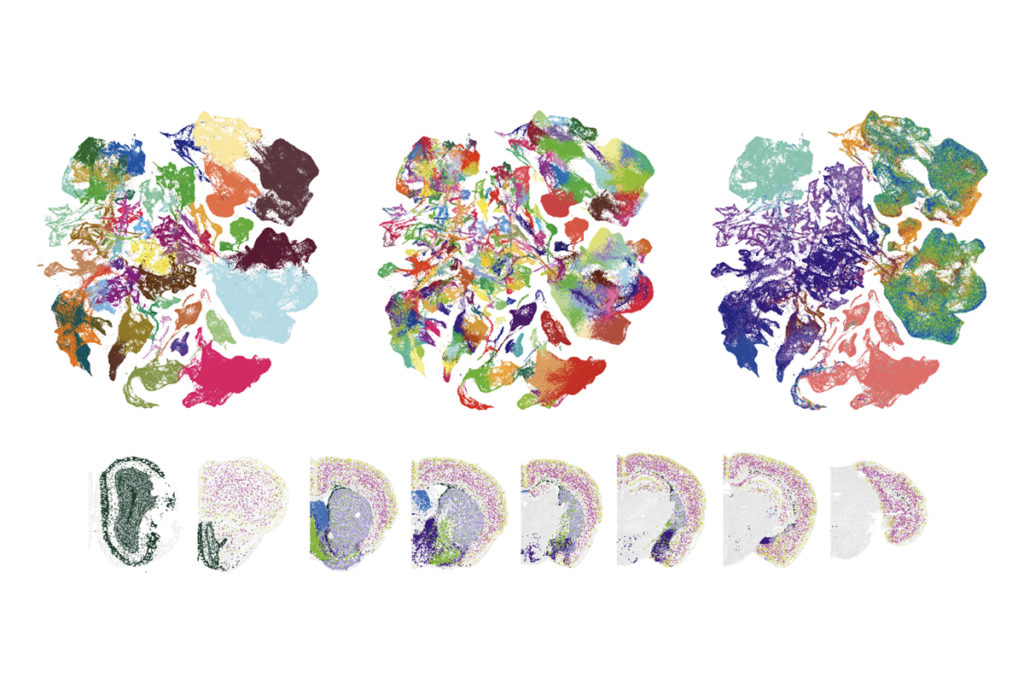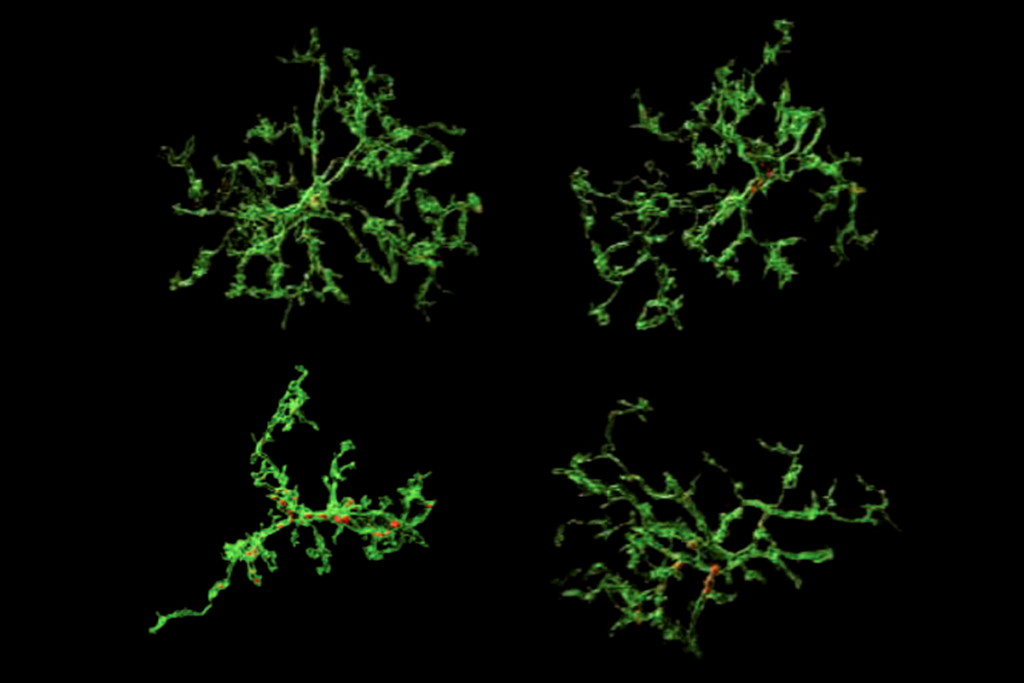Brain’s face detector lights up questions about autism’s origins
Lower activity in a key face processing region of the brain hints that people with autism could benefit from training to become ‘face experts.’
The brain’s face detector is not hard to find. To see to it, simply put someone in a magnetic resonance imaging (MRI) scanner and show them a series of images: a house, a face, a landscape, a face, a bicycle, another face. An irregular patch on the surface of the brain, just behind the ear, glows brighter in response to faces than it does for any other object or scene.
This fusiform face area (FFA) occupies a spot on the cerebral cortex — the outer shell of the brain that is responsible for complex cognitive functions — and is larger in the right hemisphere than in the left. The area “is overwhelmingly reliable in its activation and in our ability to identify it in individual people time and time and time again,” says Suzy Scherf, assistant professor of psychology and neuroscience at Penn State University in University Park, Pennsylvania.
Abnormalities in the FFA in people with autism are as easy to identify as the area itself: It tends to glow less brightly in people with autism when they look at faces than it does in controls1. “It’s not that you can’t find it,” Scherf says. “It just is a very weak signal.”
The meaning of this difference, however, is harder to pinpoint. Most scientists agree that difficulties in understanding human faces and their expressions are tied to social deficits in autism. And yet weak activation of the FFA is not at the root of the disorder.
“This is like a consequence of the social deficit, not the cause of the social deficit,” says Marlene Behrmann, professor of psychology at Carnegie Mellon University in Pittsburgh. The often faint activation of the area in people with autism may reflect their lack of motivation to look at faces, hinting at a strategy for therapy.
Finding faces:
Face processing is a complex mental task. It starts with finding faces amid a menagerie of other objects, and then recognizing individuals based on their features. It also involves parsing people’s facial expressions to understand their emotions and intentions.
The process requires basic sensory perception and social cognition — both of which are altered in autism, according to Mark Johnson, director of the Medical Research Council Centre for Brain and Cognitive Development at the University of London. “Face processing sort of bridges between those two domains,” he says.
Scientists have known for decades that a spindle-shaped fold in the cortex known as the fusiform gyrus plays a role in face processing. People who sustain damage to the area through an accident or stroke often lose the ability to recognize others’ faces.
In the 1990s, researchers began to use imaging to document the precise pattern of brain activation in response to faces. The patterns they saw led them to a patch of the fusiform gyrus now known as the FFA2,3.
Many scientists assumed the FFA is responsible for recognizing individuals by face. But as with many things in neuroscience, the region’s role turned out to be more complicated.
A 2005 study found that people with congenital prosopagnosia, a form of face blindness, show normal levels of activation in the FFA in response to faces4. “I’m still sort of reeling from this even though it was 10 years ago,” says Behrmann, who led the work.
This finding coincided with an increasing focus on brain networks across the field of neuroscience, and helped to spark a shift in how researchers conceptualize face processing in the brain. Instead of unfolding in one small region, they proposed, perhaps recognizing and understanding faces involved a network of brain areas working together5.
“Researchers typically find a constellation of patches or regions that show higher activation for faces compared to other stimuli,” says Kalanit Grill-Spector, associate professor of psychology and neuroscience at Stanford University in California.
The brightest part of this constellation, dubbed the ‘core’ face processing network, consists of the FFA as well as the superior temporal sulcus (STS), a long groove on the brain’s surface that is involved in many aspects of social behavior. Another player is the occipital face area, a part of the visual cortex located behind the FFA and thought to be involved in the early stages of face perception.
Some researchers also include the amygdala, an almond-shaped structure buried deep in the brain that processes emotions. Others place it in an ‘extended’ face processing network that draws in additional regions scattered throughout the brain and that operates to interpret faces and their expressions.
Social signals:
Without knowing the FFA’s specific role in this network, it’s difficult to tease out its role in autism.
Some evidence suggests that the region is involved in social aspects of face processing. For instance, individuals with Williams syndrome, a genetic disorder characterized by extreme sociability and a fascination with faces, show increased activation in the FFA in response to faces, compared with controls6. And people with face blindness who have intact FFAs generally don’t have autism; their disorder presents social challenges, but they may be highly attuned to social cues from voices or body language. They can even understand facial expressions, despite not knowing whose face they’re looking at.
Meanwhile, people with autism can generally recognize others by face — and yet struggle to interpret the social information encoded there. The FFA reflects these struggles, even if it doesn’t underlie them.
Last year, Scherf and her colleagues reported that people with the most severe autism symptoms show the lowest levels of FFA activation in response to faces7. (This finding may explain why some studies have found normal FFA activation in people with autism, Scherf says, as imaging studies tend to include mainly individuals with autism who have mild symptoms.)
The strongest response to faces in adolescents with autism occurs not in the FFA but in an area of the brain that typically responds to objects8. “Faces are sort of treated equivalently to objects and don’t have this sort of special status,” Behrmann says.
And yet the FFA is capable of strong activation in people with autism, just not to the typical stimulus. The FFA responds to animal as well as to human faces, and a study earlier this year found that the region lights up just as brightly in response to animal faces in people with autism as it does in controls9.
Tuning up:
Some researchers suspect that the FFA is not intrinsically specialized to respond to faces. Rather, it may reflect perceptual expertise. For example, the region lights up in expert birdwatchers when they view images of birds, in chessmasters when they look at coherent chess boards but not randomly arranged ones, and in car enthusiasts when they see a sweet set of wheels.
According to this view, neurons in the FFA become attuned to the patterns that people spend the most time studying10. For most people, that means faces, which are key to social behavior.
Studies in monkeys suggest this more broad concept of the FFA is not correct, however.
“I think that this region is truly specific for faces,” says Doris Tsao, professor of biology at the California Institute of Technology in Pasadena, who has identified and characterized six ‘face patches’ in the rhesus macaque cortex11.
Tsao used electrodes to record the activity of individual neurons in these patches as the monkeys viewed human faces, fruits and vegetables, monkey bodies, gadgets and other types of images. She found that certain neurons respond specifically to faces. These cells occasionally respond to other objects, but only ones that are also a little bit ‘face-like,’ such as clocks.
Some researchers say both theories leave out the importance of development. Children as young as age 5 show some face-selective activation in the FFA and other parts of the face processing network. But face-specific regions are larger in adults than in children, and they respond more strongly and more specifically to faces12.
Some researchers suspect that in children with autism, the normal tuning up of the FFA and other parts of the face processing network doesn’t occur. Typically developing infants are drawn to look at faces within hours of birth, and spend many hundreds of hours studying faces over the next several years13. But an infant who is not particularly drawn to faces may fail to develop the same level of face expertise.
Eventually, these patterns may give rise to the differences in FFA activation seen in individuals with autism. “What we’re all studying by the time we can get them in a scanner and look at the FFA is a lifetime result of this whole developmental process,” Scherf says.
The idea that children with autism are less motivated to look at faces is consistent with the social motivation hypothesis of autism. This theory holds that children who go on to be diagnosed with the disorder are, from infancy, less inclined to engage with others socially, and fail to develop normal social skills as a result.
“Now the question is, well, what caused them not to look at faces in the first place?” Behrmann says. “And that’s really puzzling. I’m not sure that anybody has got a good answer for it.”
Regardless of the origins of face processing abnormalities, there is some evidence that the FFA is malleable in people with autism. One particularly striking study found that an 11-year-old boy with autism who had developed an interest in Japanese cartoon monsters called Digimon showed strong activation in the FFA when looking at these characters but not when looking at human faces14. This suggests that the FFA can be trained to respond to new stimuli.
With findings such as these in mind, Scherf and her colleagues are developing a video game to help children with autism learn that faces are interesting. “I think that they just don’t know it, because their brains just have not given them the opportunity to figure it out,” Scherf says.
References:
- Schultz R.T. et al. Arch. Gen. Psychiatry 57, 331-340 (2000) PubMed
- Sergent J. et al. Brain 115, 15-36 (1992) PubMed
- Kanwisher N. et al. J. Neurosci. 17, 4302-4311 (1997) PubMed
- Avidan G. et al. J. Cogn. Neurosci. 17, 1150-1167 (2005) PubMed
- Nomi J.S. and L.Q. Uddin Neuropsychologia 71, 201-2016 (2015) PubMed
- Golarai G. et al. J. Neurosci. 30, 6700-6712 (2010) PubMed
- Scherf K.S. et al. Neuroimage Clin. 7, 53-67 (2014) PubMed
- Scherf K.S. et al. Front. Hum. Neurosci. 4, 26 (2010) PubMed
- Whyte E.M. et al. Dev. Sci. (2015) Epub ahead of print PubMed
- McGugin R.W. et al. Proc. Natl. Acad. Sci. USA 109, 17063-17068 (2012) PubMed
- Moeller S. et al. Science 320, 1355-1359 (2008) PubMed
- Natu V. et al. J. Vis. 15, 1190 (2015) PubMed
- Cohen Kadosh K. and M.H. Johnson Trends Cogn. Sci. 11, 367-369 (2007) PubMed
- Grelotti D.J. et al. Neuropsychologia 43, 373-385 (2005) PubMed
Recommended reading

Constellation of studies charts brain development, offers ‘dramatic revision’

Functional connectivity links with autism, not ADHD; and more

Ramping up cortical activity in early life sparks autism-like behaviors in mice
Explore more from The Transmitter
Daniel Nicholson discusses how Schrödinger’s book ‘What is Life?’ shaped years of biology, research

Our searchable repository of useful research can restore trust in federally funded basic science
